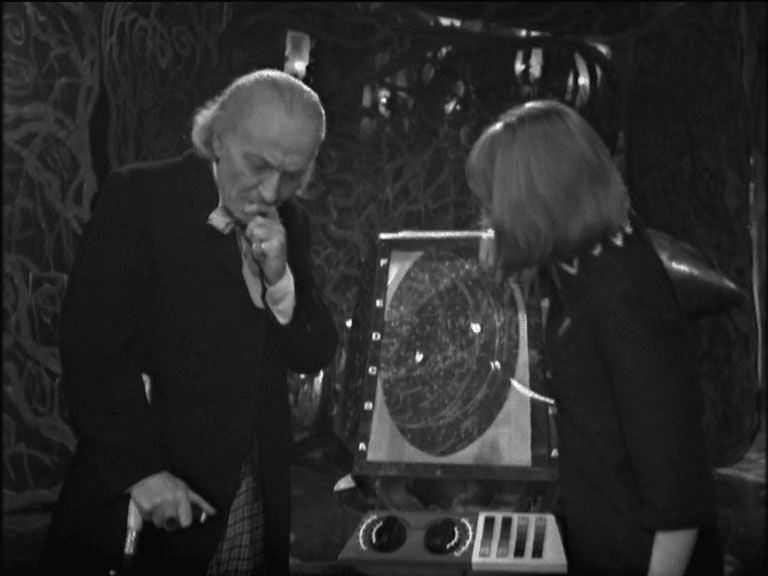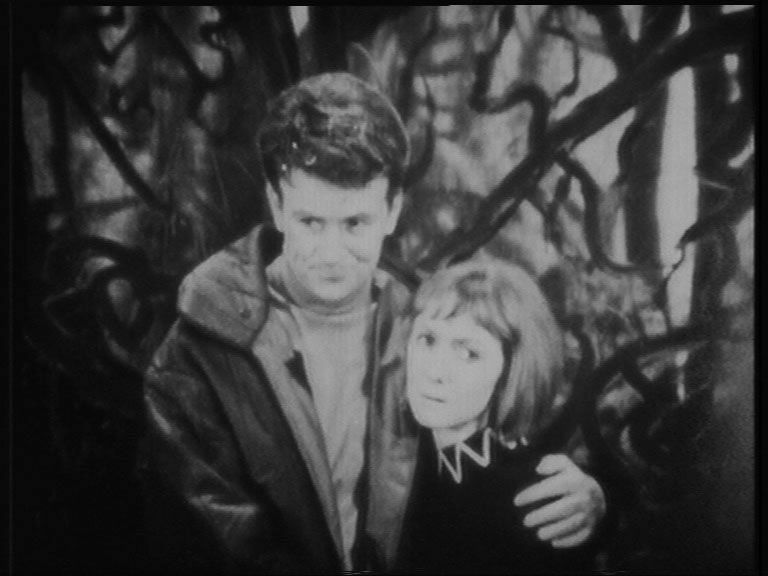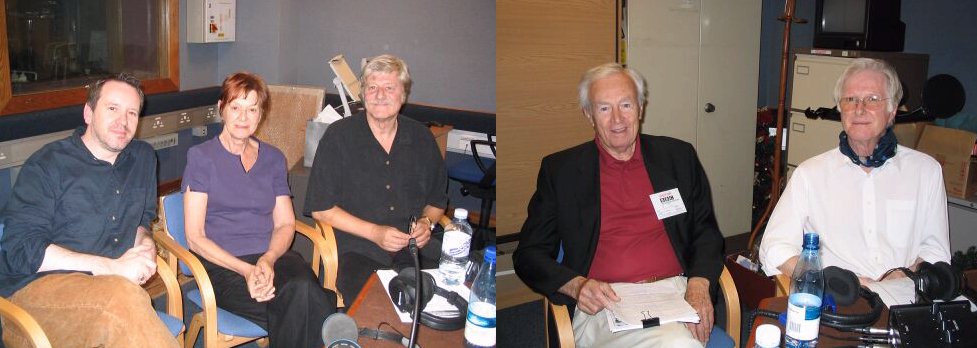The Web
Planet
The
UK's fifth DVD release for 2005 is a story which
splits fan opinion more than any other... 'The Web Planet' was an audacious
undertaking, recreating a completely alien world of giant insects with a
malevolent, cancerous enemy at its centre, all within the confines of Riverside
Studios and on a budget of only £2500 per episode. That they managed to do so
much with so little should be considered a remarkable achievement...
 'The
Web Planet' was originally shot on 405-line videotape, but now exists as 16mm
stored-field film recordings previously used to strike prints for overseas sales by BBC
Enterprises. All six episodes exist as 16mm negatives and the last five appear
to be camera negatives. There's a question mark over episode one, as it is
logged into the library system as a 'second negative', which may indicate that
either it is finegrain dupe negative or it was made in a second film recording
session. In either case it does not seem to have markedly affected the quality,
as all six episodes are in excellent condition.
'The
Web Planet' was originally shot on 405-line videotape, but now exists as 16mm
stored-field film recordings previously used to strike prints for overseas sales by BBC
Enterprises. All six episodes exist as 16mm negatives and the last five appear
to be camera negatives. There's a question mark over episode one, as it is
logged into the library system as a 'second negative', which may indicate that
either it is finegrain dupe negative or it was made in a second film recording
session. In either case it does not seem to have markedly affected the quality,
as all six episodes are in excellent condition.
Jonathan Wood was
responsible for transferring the 16mm negatives to Digital Betacam videotape on
the Spirit telecine at BBC Resources. All six episodes were 'one-light'
transferred in a single pass to ensure that the precious films were on the
machine for as short a time as possible, before they were on their way back to
the safety of the Windmill Road library. The one-light transfers were then
graded and noise-reduced and dirty cuts edited out.
Picture clean-up then
took place offline on computer-based manually retouching systems, before the
final application of the VidFIRE videoising process was applied. This is the
first Doctor Who release to see the benefit of the newly-improved VidFIRE, first
seen on the Quatermass release.
In general, this was a standard retouching
job with average amounts of VT dropout and film dirt/sparkle to be painted out,
but there were a small number of specific problems.
Episode 1: The recap from the end of
episode 4 of 'The Romans' was played in from a 35mm film recording and, in
common with much 1960s telecine material is out of phase and of lower resolution
than can be achieved now. Therefore the end of the 16mm
negative of that episode was
retransferred and the repeat insert remade, with more of the image visible and
clearer sound. All of the opening film sequence of the surface of Vortis is
also, unfortunately, out of phase. The caption of "The Web Planet" was replaced
to stop it wobbling (a film recording artefact) but unfortunately the movement
of the ethereal web behind the writer credit meant that this had to be left.
Episode 2: The filmed model sequence from
Ealing of the TARDIS being moved along the surface of Vortis had marked tramline
scratching, most of which has been painted out.
Episode 3: A 3 frame offlock (undoubtedly
caused by the flash of an on-set pyrotechnic
upsetting the synchronisation circuits in the recorder) when the "root"
fires at the TARDIS was fixed easily but 14 minutes into the episode a more
severe 12 frame offlock when the Larva Gun fires required more careful work due
to the amount of 3D movement in the image and length of disruption. Firstly, the
image was stabilised in the vertical axis in order to use as much non-corrupt
image detail as possible. Then the Foundry's Furnace plug-in for Shake was used
to interpolate details between the corrupt frames. Finally, all the repaired
elements were composited into a single layer and retouched by hand where
necessary. Click here to
download a 672Kb MPEG movie of the original fault and the fixed version.
Episode 4: About 13 minutes into the
episode, for a 3 or 4 minute period the picture suffers from intermittent severe
field sync errors and line pulling (as illustrated by the demo picture,
roll your mouse over the image to see the problem).

In most cases this was repaired either by
retouching or interpolation. However, the problem reaches a nadir in the scene
where Barbara and the Menoptera cross a section of the planet surface; here the
severity of distortion and amount of movement in the image meant an invisible
repair could not be made. However, it is now more of a mild disturbance than
previously.
Three
of the episodes have a couple of marks on the monitor tube of the film recorder.
Ideally these would be removed by blending adjacent pixels in the image.
However, with around 35,000 frames per episode it would only be feasible to do
with automated brushstrokes. This was tried, but unfortunately the film
recording was too unstable, with a vertical shift of +/- 2 scan lines across the
episode, and the position altering sufficiently to cause problems every 100
frames or so. When this happens, the defect is amplified rather than removed. An
attempt was made to motion track the screen marks in order to apply an offset to
the automated rotoscoping. While this worked well on some sections, for the most
part it was not possible to track the marks due to the low resolution of the
image and surrounding areas of similar luminance values, so the attempt at
removal of the marks was abandoned.
As is customary, the opening titles and
closing credits have been replaced with standard versions matching the originals
but without geometric distortion introduced by film recording.
The subject of the
smeary filters used to give a strange, other-worldly look to the pictures has
caused controversy for several years, so we took the opportunity to ask the
story's director, Richard Martin, to set the record straight. Richard tells us
that he wanted to add filters to the studio cameras, but no equivalent of a film
camera's matte-box (a device for mounting filters in front of the lens) existed.
He was told in no uncertain terms that he could not tamper with the expensive
camera lenses themselves, so he arranged for a crude matte-box to be
manufactured from scratch and fastened in front of the cameras. Each device held
an 'optical flat', a piece of optically perfect glass, which was then simply
smeared with Vaseline to provide the diagonal diffusion that he required.
For many years, fans
have assumed that the episodes were in poor condition, based on the VHS release
in the early nineties, which used questionable prints. As can be seen from the example
below, comparing a grab of the original VHS version with the same shot from the
new version, there is no need to worry about the quality! Roll your mouse over
the image to see the difference...

DVCam copies of both
the one-light and edited versions were sent off to Mark Ayres for audio
restoration. Mark has provided the following notes on the restoration process...
'The Web
Planet' is a story that has been much-maligned down
the years, due to its perceived cheapness. It was, however, one of the most
expensive and ambitious serials of its time, and the production team really
should be praised for trying something so audacious, even if it doesn't always
come off. In remastering the episodes, we have I think taken great pains to
bring out all that is to be admired, here. The story is, of course, fluff-city
where William Hartnell is concerned, one of the best being at the start of
episode six where he states that he and Vicki have been on "a slight
exploitation". He means "exploration". I hope.
The theme music at the top and tail of
each episode was of course replaced from my copies of the original masters, as
is usual. Episode one starts with a reprise from the end of the last episode of
the previous adventure, 'The Romans',
and this was originally played in from film. Unfortunately the fade-in at the
start is rather apologetic, so we have replaced this recap (sound and vision)
using a new transfer of the end sequence of 'The Romans'-
for one it is a generation earlier, but it also now looks as if we mean it! The
recaps at the start of every episode were in fact play-ins from a film recording
of the previous week's climax, so I do the same here, copying the end of each
episode up to the start of the next, thus saving a generation each time.
For the rest of episode one, I had two
soundtracks to choose from, an optical track and a magnetic one.
The magnetic track was actually a recording of a film optical
track from a print, but I chose to use it
in the main: as, although it was noisier, there were
far fewer other problems to deal with (film grain and "pops"). I did revert to
the optical track for one sequence (Barbara being lured from the TARDIS) as
there was a fair amount of intermodulation distortion on the track at this
point, which was less objectionable on the optical. Episodes two to six only
exist as optical tracks, so there was no decision to be made. Standard
declicking
and denoising was applied.
Throughout this adventure, there are a
couple of problems with the sound that detract quite seriously from the effect
the production team were after. Firstly there is a lot of "rostrum noise"
- the
very wooden sound of actors, cameras and crew moving around the studio, plus the
continual creaking of the heavy Zarbi costumes. While it must be remembered that
this sound is an inevitable by-product of the "as-live" nature of the original
performances, I have nevertheless (after some discussion with my colleagues)
chosen to reduce it (though rarely entirely remove it) where possible. The
difference it makes to the effect of the narrative is quite marked - an obvious
example is the sequence half way through episode two where the Doctor and Ian
are surrounded by Zarbi. In episode three, there is an infamous moment where an
approaching Zarbi collides with the camera - again, I have muted the sound of
impact slightly, but not removed it entirely!
The second problem is that picture and
sound cuts were often not very closely synchronised, most noticeably so in
episode one as the action moves in and out of the TARDIS. As part of the process
of tidying up the occasional poor edit, therefore, I have often re-synchronised
cuts. Again, it helps to push the narrative forward, rather than taking you away
from it. I hope that this has been done in a way that is sensitive to the
original technology (and often it is merely a case of adjusting some levels),
but it certainly helps to "sell" the story much better. I should point out that
all these repairs are made my making small adjustments to timings and levels, at
no point is any non-original material added or invented.
Actually, this leads on to a third
problem with this story, looking at it objectively from this distance of time.
It is, sound wise, very "empty" in places - the planet Vortis, in particular, is
as barren sound wise as it is of vegetation! I would have loved to have added
some atmosphere but this would, of course, be way beyond my brief. Perhaps, one
day, I will do my own expanded mix...!
Two episodes presented particular
problems. For episode four ('Crater of Needles')
the soundtrack is afflicted by a deep "wow" or slowly varying speed. This is
most noticeable over music, in this case the opening titles and the music cue
over the opening sequence and captions. The opening titles are of course
replaced anyway, but the music cue was really rather painful to listen to, and
something needed to be done. Trying to counteract the varying speed might have
been possible if I had a few months to spare, but the best option was to replace
it almost entirely - which is what I did. The music is 'Rapsodie
de Budapest' by Les Structures Sonores, and it just so
happens that I have a copy of the album from which this track was taken in my
collection. I made a new transfer of the piece, carefully filtered the hiss and
crackle, and laid it up against the pictures in sync with the original, removing
the film soundtrack. This was OK, of course, but there was also dialogue and
effects over the music, so these had to be carefully cut and filtered out of the
original mix, and re-introduced over the replacement music: fiddly, but worth
doing, I think! Luckily, by the time the next music cue comes in (at around
14:20) the worst excesses of the problem have abated, and I can leave well
alone.
Episode six ('The
Centre') was the most annoying. Throughout the
recording there is an insistent low-level clicking sound, possibly sprocket
noise or some other repetitive disturbance. The nightmare is that the frequency
of this interference is about eight ticks per second. All these episodes have
little clicks and pops in them; it's a product of the production method and
storage medium. And they generally have to be drawn out by hand as they are not
big enough for "click" removal software to touch them, and the edges are so
"soft" that crackle-removal plugins do not see it. In the end I spent a long day
with three different software packages, each running on a different computer,
processing both online and offline, and touching up with the pencil tool to get
a result that is passable, if not perfect. In fact the extreme levels of click
detection I used meant that a lot of "t"s and "d"s also went missing and had to
be dropped back in from an unprocessed copy of the file! In all I spent a good
day and a half on episode six. (A few years ago an off-air recording of an
episode of 'The Celestial Toymaker'
presented a not-dissimilar challenge, and on that occasion it took nearly a week
to fix - such is the progress of technology and technique!)
Once finished, the work is
double-checked to make sure that nothing has slipped or is missing, then the
episodes are bounced down to 16-bit AIF files to be laid next to the picture for
dubbing back to the DigiBeta masters.
One thing is left to be done. The
mastered episodes are dropped into the commentary recording file that we had
made at BBC TV Centre a week previously, and the commentary is mixed down to
another set of stereo AIF files - this takes me a further day. All final files
are then burned to a DVD-R for delivery.
As usual, a
commentary accompanies all six episodes. It features actors William Russell
and Martin Jarvis, producer Verity Lambert and director Richard Martin,
moderated once again by the inestimable Gary Russell.

Andrew Beech has
produced Tales of Isop, a making-of featurette, based around interviews
with Maureen O'Brien, Verity Lambert, William Russell, Martin Jarvis, Richard
Martin, make-up designer Sonia Markham and designer John Wood. John Wood brought
along the original Isoptope prop, which is used in the title sequence. The
featurette was edited by John Kelly.
William Russell reads
The Lair of Zarbi Supremo, a short story from the first Doctor Who
annual, presented as an audio feature on the disc. The entirety of the very
first Doctor Who
Annual is included on the disc in Adobe .pdf format, courtesy of Steve
Bagley.
Long time friend of the
Restoration Team, Colin Young, kindly loaned his copy of a Spanish print of
episode six, so this episode will include an option to view with Spanish
sound. Colin has also kindly loaned us the Chad Valley
Give-a-Show slides based on this story - the whole 150-minute story
condensed into 14 frames! These will be viewable as a slideshow feature on the
disc.
Ralph Montagu has once
again provided a photo gallery full of rare behind the scenes stills and
Dr. Martin Wiggins is responsible for the production subtitle notes.
Copyright Steve Roberts, Mark Ayres 22
June 2005
 'The
Web Planet' was originally shot on 405-line videotape, but now exists as 16mm
stored-field film recordings previously used to strike prints for overseas sales by BBC
Enterprises. All six episodes exist as 16mm negatives and the last five appear
to be camera negatives. There's a question mark over episode one, as it is
logged into the library system as a 'second negative', which may indicate that
either it is finegrain dupe negative or it was made in a second film recording
session. In either case it does not seem to have markedly affected the quality,
as all six episodes are in excellent condition.
'The
Web Planet' was originally shot on 405-line videotape, but now exists as 16mm
stored-field film recordings previously used to strike prints for overseas sales by BBC
Enterprises. All six episodes exist as 16mm negatives and the last five appear
to be camera negatives. There's a question mark over episode one, as it is
logged into the library system as a 'second negative', which may indicate that
either it is finegrain dupe negative or it was made in a second film recording
session. In either case it does not seem to have markedly affected the quality,
as all six episodes are in excellent condition. 

